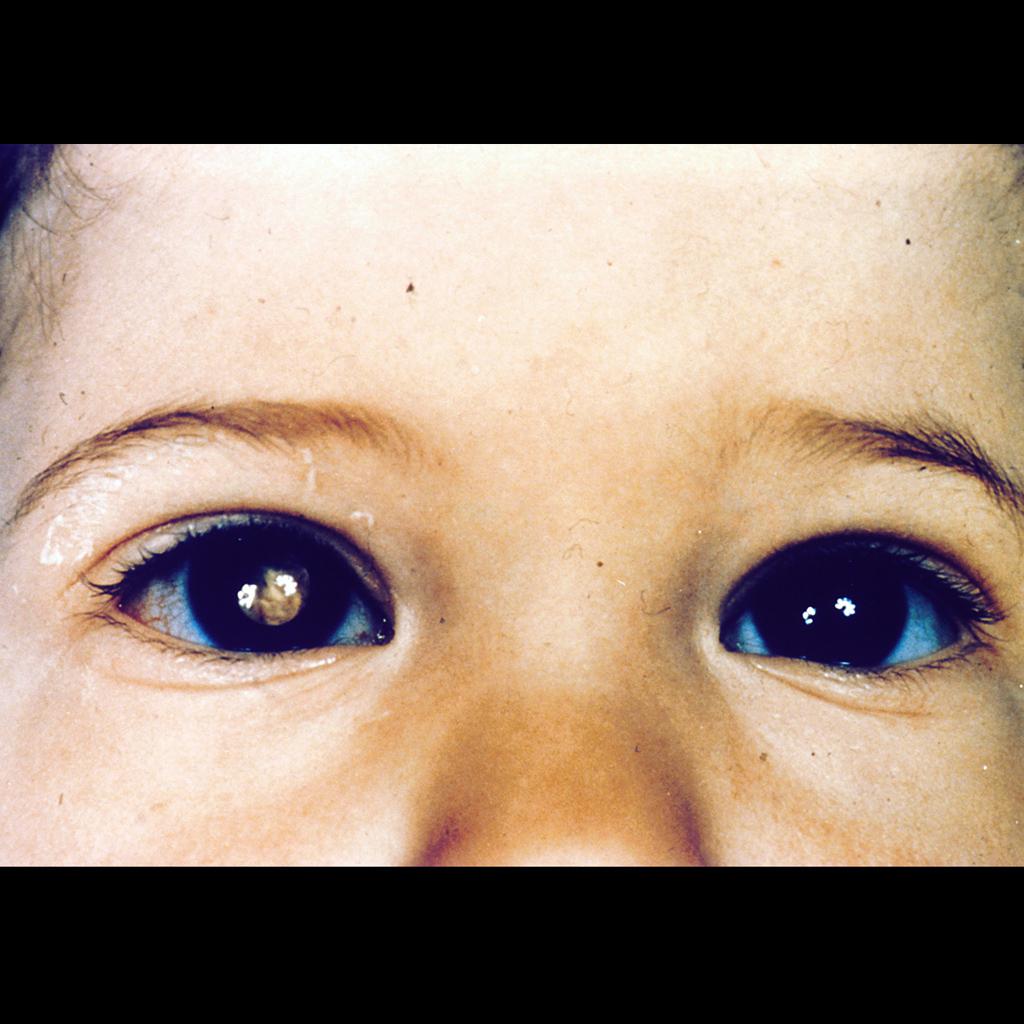Retinoblastoma history and symptoms: Difference between revisions
Simrat Sarai (talk | contribs) |
Simrat Sarai (talk | contribs) |
||
| Line 16: | Line 16: | ||
*[[Proptosis]] | *[[Proptosis]] | ||
*[[Eye pain]] | *[[Eye pain]] | ||
*[[Fever]] | *[[Fever]] | ||
*Symptoms of [[glaucoma]] which include: | *Symptoms of [[glaucoma]] which include: | ||
Revision as of 18:35, 19 October 2015
|
Retinoblastoma Microchapters |
|
Diagnosis |
|---|
|
Treatment |
|
Case Studies |
|
Retinoblastoma history and symptoms On the Web |
|
American Roentgen Ray Society Images of Retinoblastoma history and symptoms |
|
Risk calculators and risk factors for Retinoblastoma history and symptoms |
Editor-In-Chief: C. Michael Gibson, M.S., M.D. [2]Associate Editor(s)-in-Chief: Simrat Sarai, M.D. [3]
Overview
The hallmark of retinoblastoma is leukocoria which is an abnormal appearance of the retina as viewed through the pupil, also known as amaurotic cat's eye reflex.[1][2] A positive family history of retinoblastoma may be present. Less common symptoms of retinoblastoma include deterioration of vision, a red and irritated eye, eye pain, squint, proptosis, and fever.[3]
History
In taking a medical history, the doctor will ask questions about present illness, family history, risk factors, and signs and symptoms that may suggest retinoblastoma. The physician must specifically inquire about a family history of eye tumors, blindness, childhood malignancies, or enucleation. A family history of other cancers such as sarcomas should also be inquired. The parents should be asked if either strabismus and/or leukocoria have been observed. [4] Less than 10 percent of retinoblastoma patients have a positive family history for the disease.[5]
Symptoms
The most common finding of retinoblastoma is leukocoria which is an abnormal appearance of the retina as viewed through the pupil, also known as amaurotic cat's eye reflex.[1][2] Some children with retinoblastoma can develop a strabismus, nystagmus, red eye and squint which is commonly referred to as "cross-eyed" or "wall-eyed" (strabismus). Emergency referral to an ophthalmologist is warranted when a child presents with leukocoria or strabismus.[6]

Less common symptoms of retinoblastoma include:[3]
- Deterioration of vision
- Proptosis
- Eye pain
- Fever
- Symptoms of glaucoma which include:
- Severe headache
- Nausea and vomiting
- Blurred vision
- Halos around lights
References
- ↑ 1.0 1.1 Abramson DH, Beaverson K, Sangani P, Vora RA, Lee TC, Hochberg HM; et al. (2003). "Screening for retinoblastoma: presenting signs as prognosticators of patient and ocular survival". Pediatrics. 112 (6 Pt 1): 1248–55. PMID 14654593.
- ↑ 2.0 2.1 Abramson DH, Ellsworth RM, Grumbach N, Sturgis-Buckhout L, Haik BG (1986). "Retinoblastoma: correlation between age at diagnosis and survival". J Pediatr Ophthalmol Strabismus. 23 (4): 174–7. PMID 3746592.
- ↑ 3.0 3.1 Retinoblastoma. Wikipedia(2015) https://en.wikipedia.org/wiki/Retinoblastoma Accessed on October 10, 2015
- ↑ Retinoblastoma. Canadian Cancer Society(2015) http://www.cancer.ca/en/cancer-information/cancer-type/retinoblastoma/diagnosis/?region=onAccessed on October 10 2015
- ↑ Richter, Suzanne; Vandezande, Kirk; Chen, Ning; Zhang, Katherine; Sutherland, Joanne; Anderson, Julie; Han, Liping; Panton, Rachel; Branco, Patricia; Gallie, Brenda (2003). "Sensitive and Efficient Detection of RB1 Gene Mutations Enhances Care for Families with Retinoblastoma". The American Journal of Human Genetics. 72 (2): 253–269. doi:10.1086/345651. ISSN 0002-9297.
- ↑ Retinoblastoma. National Cancer Institute(2015) http://www.cancer.gov/types/retinoblastoma/hp/retinoblastoma-treatment-pdq#link/_718_toc Accessed on October 10 2015
- ↑ Image courtesy of Dr. Frank Gaillard Radiopaedia (original file [1]).[http://radiopaedia.org/licence Creative Commons BY-SA-NC